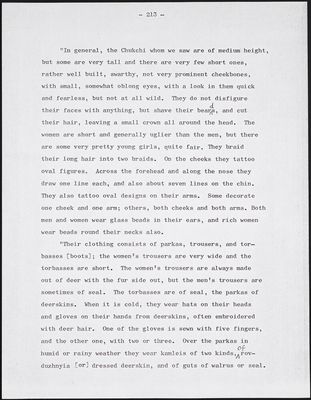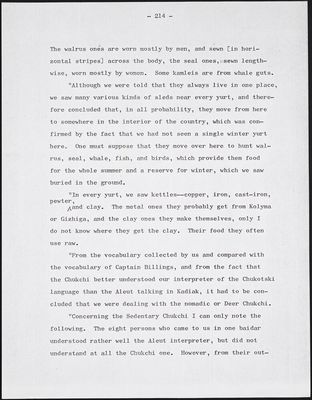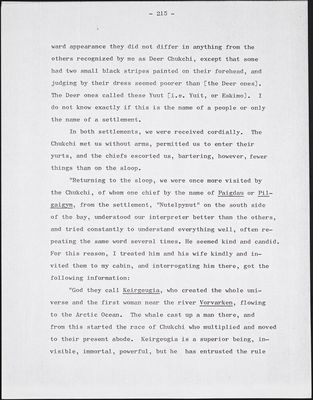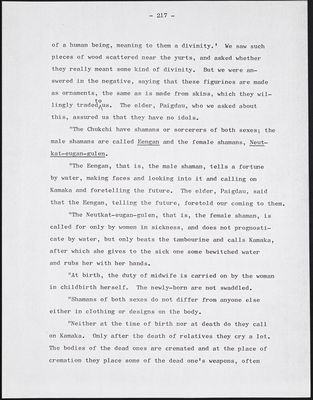Pages
mss142-vasilevShishmarev-i6-006
- 213 -
"In general, the Chukchi whom we saw are of medium height, but some are very tall and there are very few short ones, rather well built, swarthy, not very prominent cheekbones, with small, somewhat oblong eyes, with a look in them quick and fearless, but not at all wild. They do not disfigure their faces with anything, but shave their beards, and cut their hair, leaving a small crown all around the head. The women are short and generally uglier than the men, but there are some very pretty young girls, quite fair. They braid their long hair into two braids. On the cheeks they tattoo oval figures. Across the forehead and along the nose they draw one line each, and also about seven lines on the chin. They also tattoo oval designs on their arms. Some decorate one cheek and one arm; others, both cheeks and both arms. Both men and women wear glass beads in their ears, and rich women wear beads round their necks also.
"Their clothing consists of parkas, trousers, and torbasses [boots]; the women's trousers are very wide and the torbasses are short. The women's trousers are always made out of deer with the fur side out, but the men's trousers are sometimes of seal. The torbasses are of seal, the parkas of deerskins. When it is cold, they wear hats on their heads and gloves on their hands from deerskins, often embroidered with deer hair. One of the gloves is sewn with five fingers, and the other one, with two or three. Over the parkas in humid rainy weather they wear kamleis of two kinds, of rovduzhnyia [or] dressed deerskin, and of guts of walrus or seal.
mss142-vasilevShishmarev-i6-007
- 214 -
The walrus ones are worn mostly by men, and sewn [in horizontal stripes] across the body, the seal ones, wsewn lengthwise, worn mostly by women. Some kamleis are from whale guts.
"Although we were told that they always live in one place, we saw many various kinds of sleds near every yurt, and therefore concluded that, in all probability, they move from here to somewhere in the interior of the country, which was confirmed by the fact that we had not seen a single winter yurt here. One must suppose that they move over here to hunt walrus, seal, whale, fish, and birds, which provide them food for the whole summer and a reserve for winter, which we saw buried in the ground.
"In every yurt, we saw kettles--copper, iron, cast-iron, pewter, and clay. The metal ones they probably get from Kolyma or Gizhiga, and the clay ones they make themselves, only I do not know where they get the clay. Their food they often use raw.
"From the vocabulary collected by us and compared with the vocabulary of Captain Billings, and from the fact that the Chukchi better understood our interpreter of the Chukotski language than the Aleut talking in Kadiak, it had to be concluded that we were dealing with the nomadic or Deer Chukchi.
"Concerning the Sedentary Chukchi I can only note the following. The eight persons who came to us in one baidar understood rather well the Aleut interpreter, but did not understand at all the Chukchi one. However, from their out-
mss142-vasilevShishmarev-i6-008
- 215 -
ward appearance they did not differ in anything from the others recognized by me as Deer Chukchi, except that some had two small black stripes painted on their forehead, and judging by their dress seemed poorer than [the Deer ones]. The Deer ones called these Yuut [i.e. Yuit, or Eskimo]. I do not know exactly if this is the name of a people or only the name of a settlement.
In both settlements, we were received cordially. The Chukchi met us without arms, permitted us to enter their yurts, and the chiefs escorted us, bartering, however, fewer things than on the sloop.
"Returning to the sloop, we were once more visited by the Chukchi, of whom one chief by the name of Paigdau or Pilgaigym, from the settlement, "Nutelpynut" on the south side of the bay, understood our interpreter better than the others, and tried constantly to understand everything well, often repeating the same word several times. He seemed kind and candid. For this reason, I treated him and his wife kindly and invited them to my cabin, and interrogating him there, got the following information:
"God they call Keirgeugia, who created the whole universe and the first woman near the river Vorvarken, flowing to the Arctic Ocean. The whale cast up a man there, and from this started the race of Chukchi who multiplied and moved to their present abode. Keirgeugia is a superior being, invisible, immortal, powerful, but he has entrusted the rule
mss142-vasilevShishmarev-i6-009
- 216 -
over earth to another creature, Kamaka, also invisible and immortal, but wicked, punishing disobedience by death. That is why it is said about one who dies: he is taken by Kamaka. Sacrifices are offered only to Kamaka.
"In ancient times, they sacrificed human beings of both sexes, but only old ones, never young ones, and always their own, never prisoners. The victims offered were killed and buried in the ground, from which the foxes and wolves dug them out, tore them apart, and devoured them. The bodies of those who died a natural death were always burned. But human sacrifice was abandoned long ago. As is known from legends, the Chukchi were never cannibals.
"Concerning present-day sacrifices, we could not get any details. We only saw, a little way from the settlement Nuniagma, planted into the ground in a square, two whale jawbones and two whalebones and in the middle, two heads and one rib. The chief who was with us glued to each of these objects by means of mucus, a tiny leaf of tobacco received from us, explaining to us that this was an offering. However, we could not learn from him whether this offering was for the whale or Kamaka. He only said that he also gave a piece from every hunt, not excluding the whale, and from every acquisition. From this, one concludes that the offering is made to Kamaka. We saw such altars for offerings in every settlement.
"In the voyage of Billings it is said that the Chukchi 'get their fire from small pieces of wood, shaped in the form
mss142-vasilevShishmarev-i6-010
-217-
of a human being, meaning to them a divinity.' We saw such pieces of wood scattered near the yurts, and asked whether they really meant some kind of divinity. But we were answered in the negative, saying that these figurines are made as ornaments, the same as is made from skins, which they willingly traded to us. The elder, Paigdau, who we asked about this, assured us that they have no idols.
"The Chukchi have shamans or sorcerers of both sexes; the male shamans are called Eengan and the female shamans, Neutkat-eugan-gulen.
"The Eengan, that is, the male shaman, tells a fortune by water, making faces and looking into it and calling on Kamaka and foretelling the future. The elder, Paigdau, said that the Eengan, telling the future, foretold our coming to them.
"The Neutkat-eugan-gulen, that is, the female shaman, is called for only by women in sickness, and does not prognosticate by water, but only beats the tambourine and calls Kamaka, after which she gives to the sick one some bewitched water and rubs her with her hands.
"At birth, the duty of midwife is carried on by the woman in childbirth herself. The newly-born are not swaddled.
"Shamans of both sexes do not differ from anyone else either in clothing or designs on the body.
"Neither at the time of birth nor at death do they call on Kamaka. Only after the death of relatives they cry a lot. The bodies of the dead ones are cremated and at the place of cremation they place some of the dead one's weapons, often




